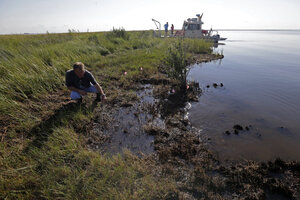Gulf oil spill: how wildlife is still challenged four years later
A report released Tuesday describes ongoing difficulties for sea turtles, bottlenose dolphins, brown pelicans, and other species as a result of the Gulf oil spill in 2010.

PJ Hahn, Coastal Zone Manager for Plaquemines Parish, examines oil along the shoreline of Bay Jimmy, which was heavily impacted by the Deepwater Horizon oil spill, in Plaquemines Parish, La., in September 2013.
Gerald Herbert/AP
Four years after the Gulf of Mexico oil spill released more than 200 million gallons of crude into the water, a leading environmental organization says the migratory and reproductive cycles of area wildlife have been severely altered and at least one species of sea turtles is close to extinction.
The National Wildlife Federation (NWF) report, issued Tuesday, focused on 14 water, air, and land species located in the northern Gulf and affected by the oil spill, using data from independent scientists and the National Oceanic and Atmospheric Administration (NOAA).
“Four years later, wildlife in the Gulf are still feeling the impacts of the spill,” Doug Inkley, senior scientist for the NWF, told reporters in a teleconference Tuesday. “The science is telling us that this is not over.”
The Gulf of Mexico oil spill occurred after an explosion at an oil rig on April 20, 2010, killing 11 people. The spill is among the worst environmental disasters in American history, sending crude gushing into the Gulf’s delicate ecosystem of marshes, streams, and beaches.
Evidence early on indicated that wildlife was slicked with oil, but scientists say the most profound environmental damage can only be tracked over years. They use the 1989 Exxon Valdez oil spill off the coast of Alaska as an example: Twenty-five years later, scientists say, some species have not yet fully recovered.
According to Tuesday’s report:
• Tens of thousands of sea turtles suffered oil exposure. The number of Kemp’s Ridleys, one of five species of sea turtles in the Gulf and the one considered the most endangered, fell 35 percent between 2009 and 2010 and has been “flat-lined” since, according to Pamela Plotkin, an associate research professor of oceanography at Texas A&M University in College Station. “We’re really concerned ... that there have been some long-term impacts as a result of the oil spill,” she says.
• More than 900 bottlenose dolphins have been found dead or stranded since 2010. Those that have survived have been evaluated as underweight or anemic.
• Nearly a thousand brown pelicans collected since the spill were exposed to oil, and half of them died. Oil also contaminated island mangrove thickets that are used for nesting, suggesting that the number of brown pelicans in the long term will be stunted.
• Chemicals traced to the spill have been linked to irregular heartbeats in the embryos of bluefin and yellowfin tuna.
• Sperm whales known to live in the spill area have been deemed to have higher levels of chromium, nickel, and other metals in their bodies than they did before the spill.
• Coastal birds, particularly loons, are thought to carry an increased concentration of toxic oil compounds in their blood.
The 2010 oil rig explosion launched thousands of lawsuits and a complex federal trial separated into three phases. BP, the British oil giant responsible for the spill, pleaded guilty to 11 felony counts of misconduct and negligence related to the 11 deaths, as well as one misdemeanor count under the Clean Water Act and one misdemeanor count under the Migratory Bird Treaty Act. It also pleaded guilty to one felony count of obstruction of Congress, related to incorrect flow-rate estimates given to Congress in the first 14 days of the disaster.
As a result, the company agreed to a $4 billion fine, making it the largest corporate criminal penalty in US history.
It was also the federal trial that made the determination that more than 200 million gallons of oil (about 5 million gallons) spilled. The amount of oil involved had been disputed since the disaster.
As of March, the third phase of the trial was set for January 2015. It will determine how much BP, and its partners, must pay for violating the federal Clean Water Act. The maximum allowable fine is $18 billion.

